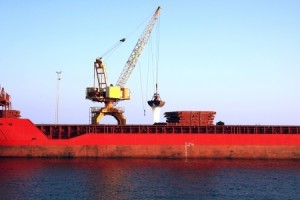TOXICITY TESTS IMPROVE THE ASSESSMENT OF HARBOUR SEDIMENT QUALITY
TOXICITY TESTS IMPROVE THE ASSESSMENT OF HARBOUR SEDIMENT QUALITY
Harbour sediments should be tested for their toxic effects on living organisms in addition to being subject to the chemical, physical and biological tests usually conducted to assess water quality, according to recent research from Portugal.
This would provide a better environmental assessment of dredged material to help guide port authorities’ decisions on its disposal.
Under the Water Framework Directive (WFD)1, all EU Member States are required to manage water bodies so that they achieve ‘good chemical status’ and ‘good ecological status’ or, in the case of heavily modified water bodies, such as ports, ‘good ecological potential’ by 2015.
Assessment of the chemical status has to take into account the concentrations of a list of priority pollutants, while that of ecological status or potential has to take into account the concentrations of other substances discharged in significant quantities into the water body, as well as biological and hydromorphological factors. (Hydromorphology is a term used in river basin management to describe the combination of hydrological and geomorphological (structural) processes and attributes of rivers, lakes, estuaries and coastal waters).
As part of the EU-funded PORTONOVO Project2, this study assessed the status of water in the Port of Aveiro, which is located in a lagoon on the Portuguese coast. Some human activities in the port area release contaminants that can settle in the bottom sediments. The sediments can act as a source of pollution if they are later disturbed by natural or human processes.
In 2010, samples of water and sediment were collected from five sites, including a reference site within a bay of the lagoon, and tested for physical and chemical properties, including the pH, temperature and electrical conductivity, as well as for metals, polychlorinated biphenyls (PCBs) and polycyclic aromatic hydrocarbons (PAHs), all of which can remain in the environment for a long time.
The tests revealed that all the water samples had similar physical and chemical properties (e.g. salinity and phosphate concentrations) with the reference site having the best water quality – Level 1 according to the Sediment Quality Criteria under the Portuguese legislation. Sediment from the four port sites was classified as between Levels 1 and 2, owing to its higher metal content. Metal contamination varied according to depth. For example, one site had zinc concentrations in the seabed sediment of 98.10 micrograms per gram (µg/g) of dry sediment and 199.40 µg/g at 5cm and 30cm depth, respectively.

Concentrations of PCBs and PAHs were within the range for Level 1. Overall, these four sites were therefore classed as having ‘trace amounts of contaminants’, which means that port authorities would have to take existing background levels of pollutants into account when choosing where to dump any material dredged from these sites.
The levels of the contaminants determined in the physical and chemical tests would not on their own be expected to pose a risk to organisms living in the sediment. However, toxicity tests carried out using luminescent bacteria, the light output of which changes if their metabolic processes are damaged by toxic chemicals, revealed that port sediment from all depths studied contained toxic material which was at levels high enough to pose some risk to seabed organisms. The researchers suggest that interactions between the various pollutants could be making the sediment more toxic than suggested by the concentrations of the individual contaminants.
The results of this study suggest that the physical, chemical and biological monitoring already carried out on sediments under the WFD should be complemented by eco-toxicity tests to provide a more complete picture of the condition of port waters.
- See: http://ec.europa.eu/environment/water/flood_risk/index.htm
- PORTONOVO was supported by the European Regional Development Fund. See: www.portonovoproject.org
Source: Gonçalves, S.F., Calado, R., Gomes, N.C.M. et al. (2013) An ecotoxicological analysis of the sediment quality in a European Atlantic harbor emphasizes the current limitations of the Water Framework Directive. Marine Pollution Bulletin. 72: 197–204. Doi.org/10.1016/j.marpolbul.2013.04.003.
